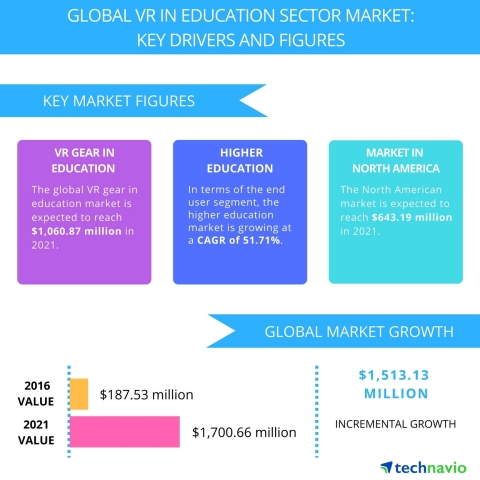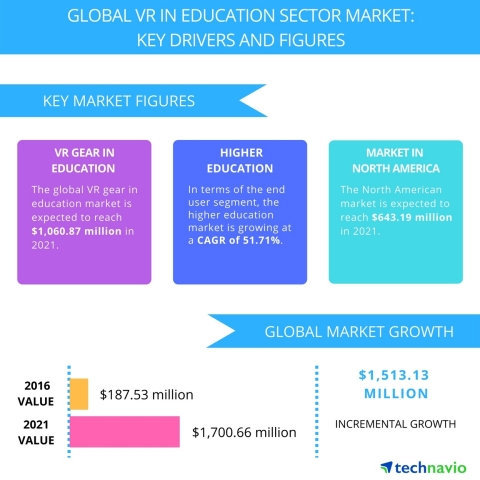LONDON--(BUSINESS WIRE)--Technavio’s latest report on the global VR in the education market provides an analysis of the most important trends expected to impact the market outlook from 2017-2021. Technavio defines an emerging trend as a factor that has the potential to significantly impact the market and contribute to its growth or decline.
Jhansi Mary, a lead analyst from Technavio, specializing in research on education technology sector, says, “Within the K-12 segment, the appropriate application of VR will take time as educators have just realized the benefits of VR from a technical and immersive learning perspective. It is extremely important for educators to understand that K-12 students are young and in their formative years, and the use of VR at this stage can strongly influence their overall personality.”
The global VR in the education market is expected to reach USD 1,700.66 million in 2021, growing at a CAGR of more than 55%. Regionally, North America is expected to dominate the market due to the growing investment and higher adoption of technology in the education sector. Based on the product segment, the VR content segment is expected to grow at a higher CAGR during the forecast period, owing to its inherent requirements and the high demand in the learning environment.
Looking for more information on this market? Request a free sample report
Technavio’s sample reports are free of charge and contain multiple sections of the report including the market size and forecast, drivers, challenges, trends, and more.
The top three emerging trends driving the global VR in the education market according to Technavio research analysts are:
Incorporation of SLAM technology
Simultaneous localization and mapping (SLAM) is a popular and important autonomous mapping and navigation technique in mobile robotics. This technology was mainly used in NASA robots for the creation of unknown environments maps. Also, given its high accuracy feature, it is used in their positioning devices.
“SLAM technology is expected to be used in smartphones integrated with VR headsets; wherein positioning can be enabled on the web using the smartphone's camera, which will allow a user to visualize and interact in the VR environment,” according to Jhansi.
Increasing use of VR in medical training
The use of VR in medical schools has become popular for instructing and educating young students. The VR platform provides medical students an interactive method to learn and understand various aspects of medical education.
From the institution's perspective, the use of VR saves huge time and resources, as it does not have to go through the traditional training process in many aspects. Students will be more comfortable in dealing with virtual scenarios, as it allows the higher probability of trail and errors, due to which students can repeat the process as often as required.
VR facilitates collaborative learning
Virtual collaboration is already the norm in the current world, whether through email, basecamp, Google docs, or other virtual spaces. VR takes the collaboration further by providing a common space that looks and feels like a shared room, giving the feeling of sharing a physical space with other users.
A virtual space to collaborate in the education sector will allow students from different regions to interact and collaborate with each other. For example, a student studying fifth grade in India can share a space with a student of fifth grade in the US and can collaborate in real space, which surpasses email or video conferencing.
The key vendors are as follows:
- Oculus VR
- Alchemy VR
- Discovery Communications
Browse Related Reports:
- Global Interactive White Board Market 2017-2021
- Global Corporate Game-Based Learning Market 2017-2021
- Global Digital Signage Market in Education Sector 2017-2021
Become a Technavio Insights member and access all three of these reports for a fraction of their original cost. As a Technavio Insights member, you will have immediate access to new reports as they’re published in addition to all 6,000+ existing reports covering segments like in-vitro diagnostics, oncology, and vaccines. This subscription nets you thousands in savings, while staying connected to Technavio’s constant transforming research library, helping you make informed business decisions more efficiently.
About Technavio
Technavio is a leading global technology research and advisory company. The company develops over 2000 pieces of research every year, covering more than 500 technologies across 80 countries. Technavio has about 300 analysts globally who specialize in customized consulting and business research assignments across the latest leading edge technologies.
Technavio analysts employ primary as well as secondary research techniques to ascertain the size and vendor landscape in a range of markets. Analysts obtain information using a combination of bottom-up and top-down approaches, besides using in-house market modeling tools and proprietary databases. They corroborate this data with the data obtained from various market participants and stakeholders across the value chain, including vendors, service providers, distributors, re-sellers, and end-users.
If you are interested in more information, please contact our media team at media@technavio.com.




